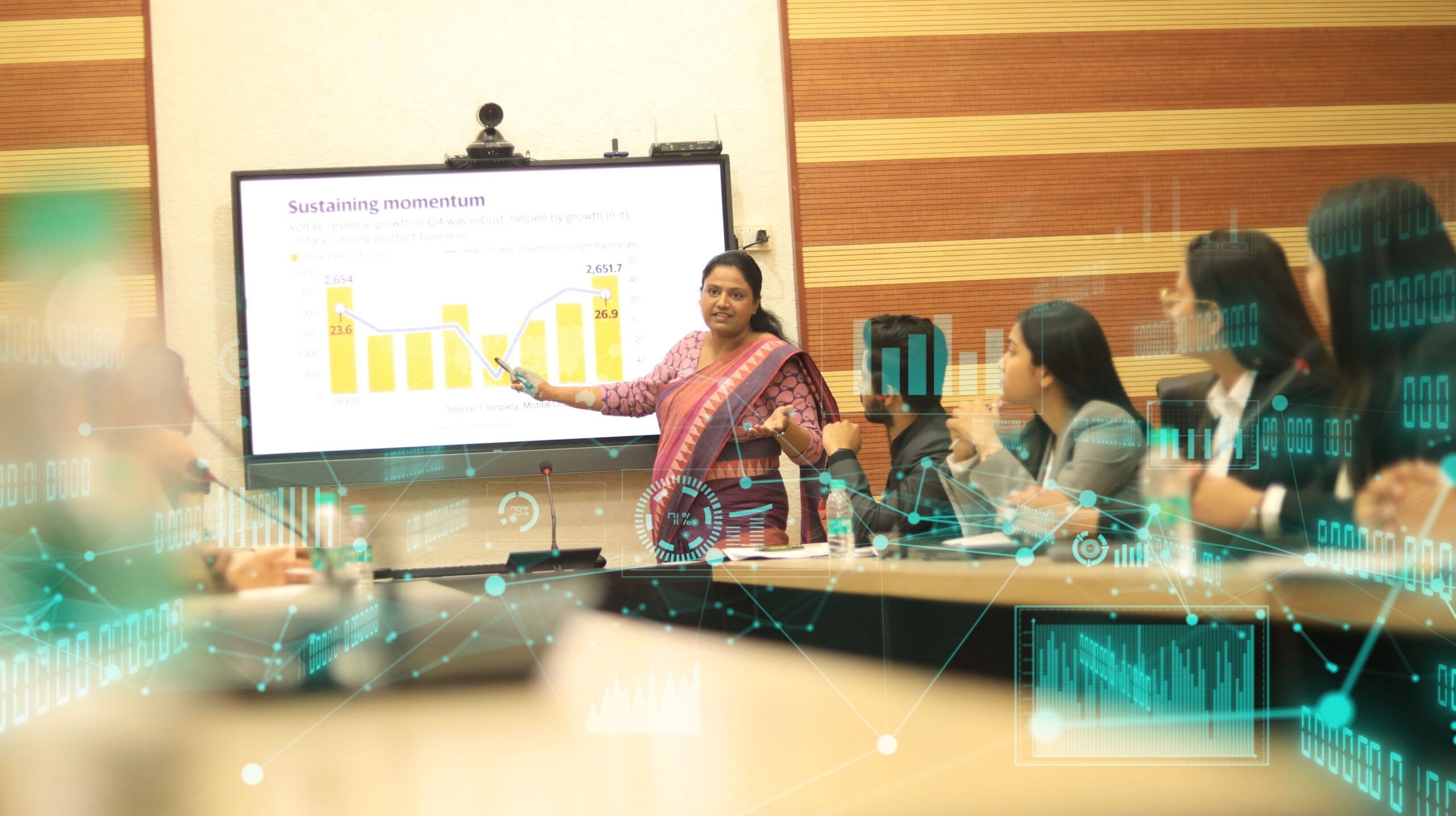Starting a career in data science may be both thrilling and challenging. To gain a career in this competitive profession, candidates must go through rigorous interview processes where they demonstrate their ability in analyzing and interpreting complex information, programming, and machine learning, among other talents.
This article includes 21 data science interview questions and answers to help students prepare thoroughly. It covers a wide range of topics, from statistical approaches to machine learning algorithms and data visualization techniques and provides a thorough overview for anyone looking to ace a data science interview.
What is Data Science?
Data science is the process of extracting knowledge and insights from structured and unstructured data using scientific methods, algorithms, procedures, and systems. It analyzes and interprets complex sets of data using expertise from a variety of fields, including statistics, computer science, machine learning, data engineering, and domain-specific knowledge.
Furthermore, data scientists employ a variety of languages, including Python and R. They frequently employ data analysis tools such as pandas, NumPy, and scikit-learn, as well as machine learning libraries.
Data Science Interview Questions & Answers
Here is a collection of the most common data science interview questions about technical concepts and how to develop the answers.
Ques1: What is Data Science? How does it differ from Data Analytics?
Ans 1: Data Science encompasses a wider scope that includes creating algorithms, data modeling, and creating predictive models to extract insights from data, not just analyze it. Data Analytics is more focused on processing and performing statistical analysis on existing datasets. Analysts look for trends, test hypotheses, and make predictions.
Ques 2: Explain the data science project lifecycle.
Ans 2: Here is a Data Science project lifecycle:-
- Problem Definition: Identify and define the problem or question that needs to be solved.
- Data Acquisition: Gather the required data from various sources.
- Data Cleaning: Prepare the data by cleaning and handling missing values, anomalies, and noise.
- Data Exploration/Analysis: Explore the data to find patterns, trends, and correlations.
- Feature Engineering: Create new features from the existing data to improve model performance.
- Model Selection: Choose appropriate models based on the problem type.
- Model Training: Train the models using the prepared dataset.
- Model Evaluation: Assess the model’s performance using suitable metrics.
- Model Tuning: Fine-tune the model parameters for optimal performance.
- Deployment: Deploy the model to a production environment.
- Monitoring and Maintenance: Monitor the model’s performance and update it as needed to adapt to new data or requirements.
Ques 3: Describe the difference between supervised and unsupervised learning.
Ans3: The difference between Supervised Learning and Unsupervised Learning are as follow:
| Category | Supervised Learning | Unsupervised Learning |
| Definition | Supervised learning refers to that part of machine learning where we know what the target variable is and it is labeled. | Unsupervised Learning is used when we do not have labelled data and we are not sure about our target variables. |
| Objective | The objective of supervised learning is to predict an outcome or classify the data | The objective here is to discover patterns among the features of the dataset and group similar features together. |
| Algorithms | Some of the algorithm types are: Regression (Linear, Logistic, etc.) Classification (Decision Tree Classifier, Support Vector Classifier, etc.) | Some of the algorithms are : Dimensionality reduction (Principle Component Analysis, etc.) Clustering (KMeans, DBSCAN, etc.) |
| Evaluation Metrics | Supervised learning uses evaluation metrics like: Mean Squared Error Accuracy | Unsupervised Learning uses evaluation metrics like: Silhouette Inertia |
| Use Cases | Predictive modeling, Spam detection | Anomaly detection, Customer segmentation |
Ques 4: What is linear regression? When would you use it?
Ans4: Linear regression is a statistical method used to model the relationship between a dependent variable and one or more independent variables by fitting a linear equation to observed data.
It’s primarily used for prediction and causal inference. You would use linear regression when you want to predict a continuous outcome variable based on the value of one or more predictor variables. It’s ideal for understanding the impact of changes in predictors on the outcome.
Ques 5: Explain the concept of overfitting and how to prevent it.
Ans 5: Overfitting occurs when a model learns the detail and noise in the training data to the extent that it negatively impacts the performance of the model on new data. This means the model has learned the training data too well, including its anomalies.
To prevent overfitting, techniques such as cross-validation, regularization, and pruning (for decision trees) can be used. Simplifying the model by reducing the number of features or using more training data can also help.
Ques 6: What is cross-validation, and why is it important?
Ans 6: Cross-validation is a technique used to assess how the statistical analysis will generalize to an independent dataset. It is primarily used in settings where the goal is prediction, and one wants to estimate how accurately a predictive model will perform in practice. It involves partitioning a dataset into a set of complementary subsets, training the model on one subset (training set), and validating it on the other subset (validation set).
Cross-validation is important because it helps in avoiding overfitting, making the model more generalizable.
Ques7: Describe a decision tree algorithm. How does it work?
Ans7: Decision trees are a popular machine learning algorithm used for both classification and regression tasks. They work by creating a tree-like structure of decisions based on input features to make predictions or decisions. Lets dive into its core concepts and how they work briefly:
- Decision trees consist of nodes and edges.
- The tree starts with a root node and branches into internal nodes that represent features or attributes.
- These nodes contain decision rules that split the data into subsets.
- Edges connect nodes and indicate the possible decisions or outcomes.
- Leaf nodes represent the final predictions or decisions.
The objective is to improve data homogeneity, which is frequently quantified using metrics such as mean squared error (for regression) and Gini impurity (for classification). Decision trees can handle a wide range of properties and accurately record complex data interactions. They can, however, overfit, particularly when the data is deep or complicated. To avoid overfitting, methods such as pruning and limiting tree depth are used.
Ques 8: What are neural networks and its basic components?
Ans 8: A neural network is a series of algorithms that endeavors to recognize underlying relationships in a set of data through a process that mimics the way the human brain operates. Its basic components include:
- Input Layer: The layer that receives the input signal to be processed.
- Hidden Layers: Layers that perform computations and transfer information from input to output layers.
- Output Layer: The layer that produces the final output of the network.
- Weights and Biases: Parameters that are adjusted through learning.
- Activation Function: Determines if a neuron should be activated or not.
Ques 9: How do you handle missing or corrupted data?
Ans 9: Handling missing or corrupted data is crucial to maintaining data integrity and analytical correctness. Imputation methods substitute missing values with statistical estimates or forecasts based on the remaining data, preserving as much information as feasible. Dropping the necessary rows or columns is a simpler method, but you risk losing crucial data. The approach used is defined by the dataset’s features and analytic goals, and it must strike a balance between information retention and the likelihood of bias.
Ques 10: Explain clustering and classification?
Ans 10: Clustering and classification are essential techniques in the field of machine learning. Clustering is an unsupervised learning method that use specified labels to group related data points together.
On the other hand, classification is a supervised learning methodology that involves the assignment of data points to predetermined categories according to their attributes. This process relies on labeled training data to acquire the necessary knowledge for categorization.
Ques 11: What is a Confusion Matrix?
Ans 11: A confusion matrix is a specific table layout that allows visualization of the performance of an algorithm, typically a supervised learning one. It is especially useful in binary classification to understand the number of correct and incorrect predictions made by the model, categorized into true positives, false positives, true negatives, and false negatives.
Ques 12: Explain the bias-variance tradeoff?
Ans 12: The bias-variance tradeoff is an important concept that addresses the relationship between a model’s complexity and its ability to generalize to previously unseen data. High bias can cause underfitting, which occurs when the model is overly simplistic in capturing underlying trends. High variance can lead to overfitting, in which the model captures noise rather than the signal. Optimal model complexity minimizes both bias and variance, which enhances predictive performance.
Ques 13: What is Principal Component Analysis (PCA)?
Ans 13: Principal Component Analysis (PCA) is a statistical method for dimensionality reduction. It reduces a huge set of variables into a smaller one while keeping the majority of the original dataset’s variability. By identifying the primary components, PCA helps to reduce dimensionality, simplifying the dataset while preserving its essential patterns or features.
Ques 14: How does a Random Forest work?
Ans 14: A Random Forest works by constructing multiple decision trees during the training phase and outputting the mode of the classes (for classification tasks) or mean prediction (for regression tasks) of the individual trees. The findings from several trees are averaged in this ensemble method, which increases prediction accuracy and reduces overfitting.
Ques 15: Explain Gradient Descent?
Gradient Descent is an optimization procedure that reduces the cost function of a model. It operates by iteratively moving towards the function’s minimal value while modifying the parameters based on the gradient (or slope) of the cost function. This process helps in finding the set of parameters that best fits the model to the data.
Ques 16: What is K-means clustering?
K-means clustering is an unsupervised learning algorithm that partitions unlabeled data into a predefined number of clusters based on similarity. Each data point is assigned to the nearest cluster center, with the aim of minimizing the variance within each cluster. The process iterates until it finds the most cohesive clustering arrangement.
Ques 17: Explain the ROC curve?
The ROC (Receiver Operating Characteristic) curve is a graphical plot that illustrates the diagnostic ability of a binary classifier system as its discrimination threshold is varied. It plots the true positive rate against the false positive rate, helping in evaluating the trade-offs between true positive detections and false alarms.
Ques 18: What is Time Series Analysis?
Ans 18: Time Series Analysis examines data points collected or indexed in time order to identify trends, cycles, and patterns over time. It’s used for forecasting future values by analyzing past observations, crucial in fields like economics, finance, and weather forecasting, where data points are dependent on time.
Ques 19: What is the difference between “long” and “wide” format data?
Ans 19: The wide format data arranges data such that each subject’s responses across different time points or conditions are spread across multiple columns. The long format data, however, stacks all the responses in a single column, with another column indicating the time point or condition, making each row a unique time point or condition for each subject.
Ques 20: Explain A/B testing?
Ans 20: A/B testing, also known as split testing, is a method to compare two versions of a webpage or app against each other to determine which one performs better. By showing version A to one group and version B to another, it allows for statistical analysis of which variation achieves better performance on a given metric, such as conversion rates.
Ques 21: What is feature selection and why is it important?
Ans 21: Feature selection involves choosing the most relevant variables for use in model construction. It is crucial because it simplifies models, makes them easier to read, reduces training time, and can help enhance model performance by removing irrelevant or redundant features that may lead the model to perform badly on unknown data.
In conclusion, knowing how to answer these 21 common data science interview questions and answers will make you feel much more confident and ready for data science jobs. It’s crucial to not only understand these concepts theoretically but also to be able to apply them practically in real-world scenarios.
At Uttaranchal University, the Placement and Training Cell, along with the dedicated professors of the Uttaranchal Institute of Technology(UIT), help students prepare for their placements. The university prepares students to face difficult interview questions and flourish in their data science jobs by combining a demanding academic curriculum, hands-on workshops, and mock interview sessions. This comprehensive approach to learning and career preparation is what sets Uttaranchal University‘s students apart in the competitive job market.
Article written by
Blog Categories
- 1
- 3
- 1
- 1
- 17
- 8
- 16
- 1
- 1
- 1
- 1
- 1
- 1
- 2
- 1
- 1
- 5



